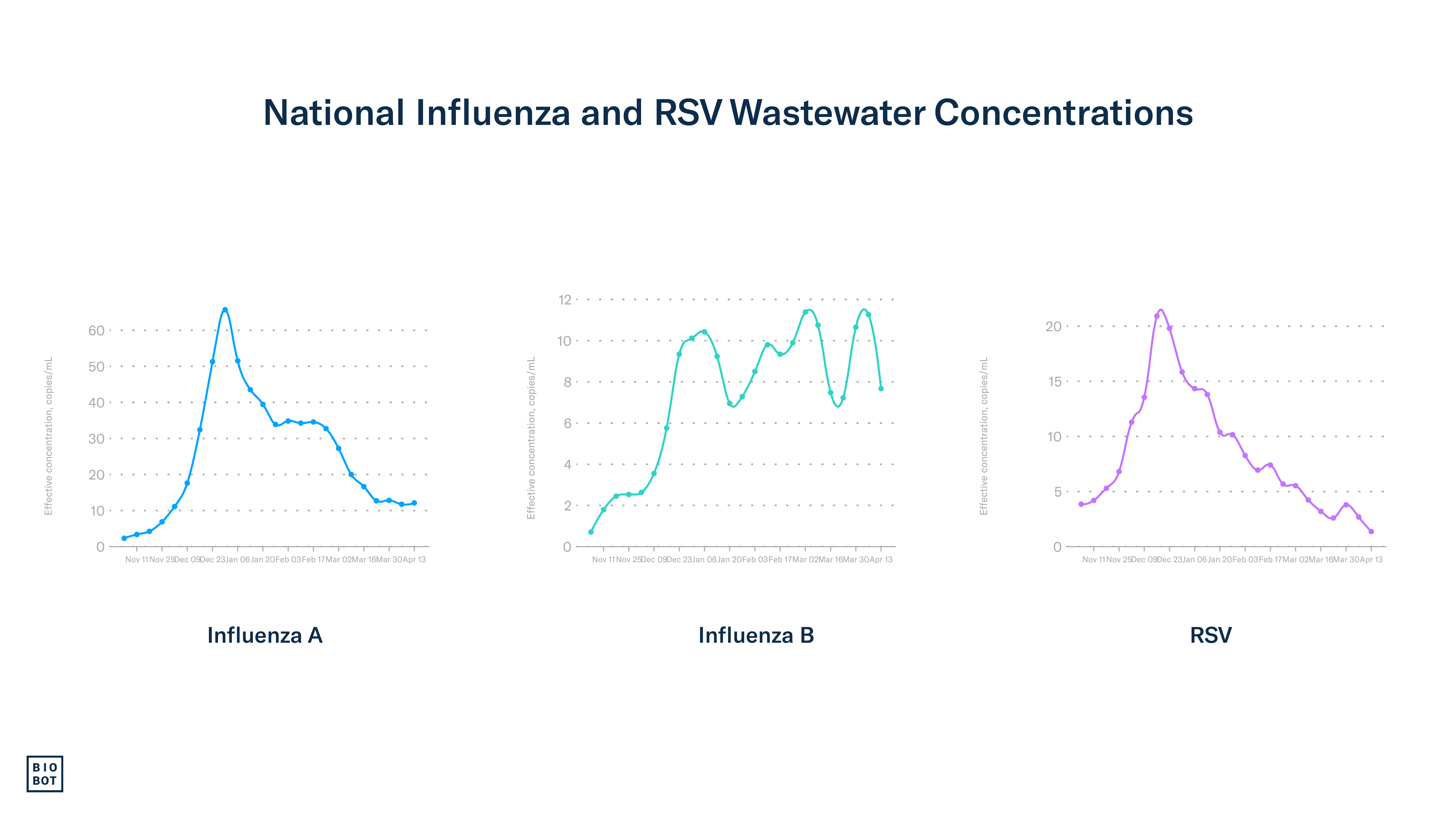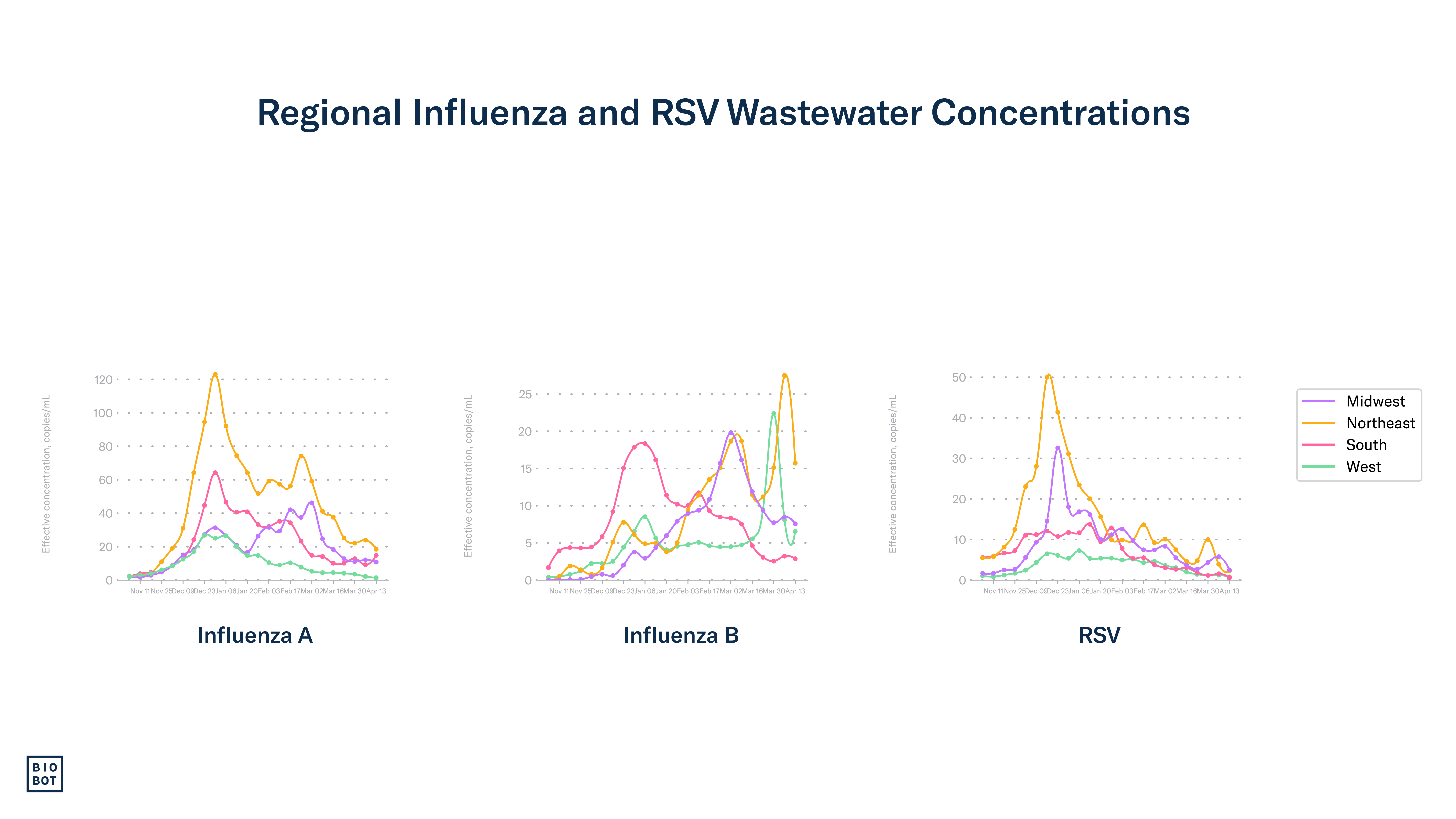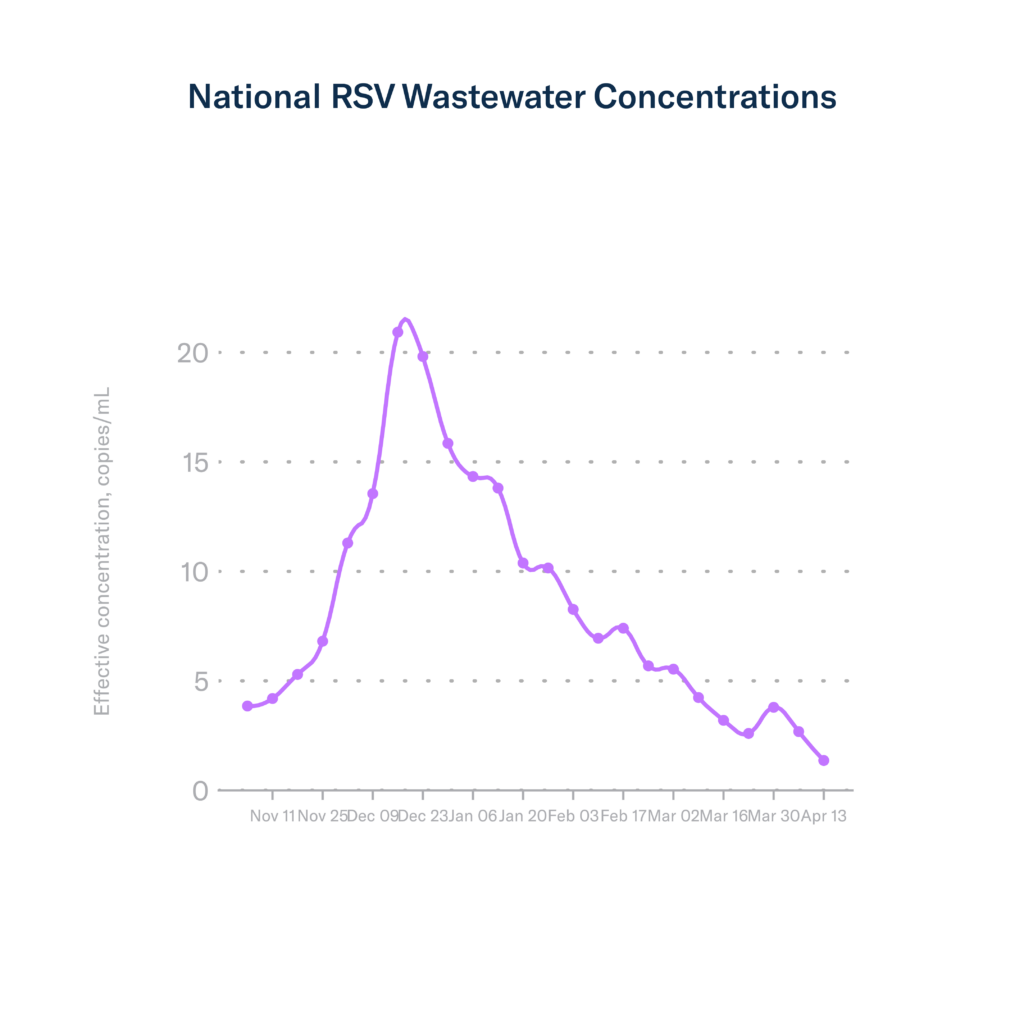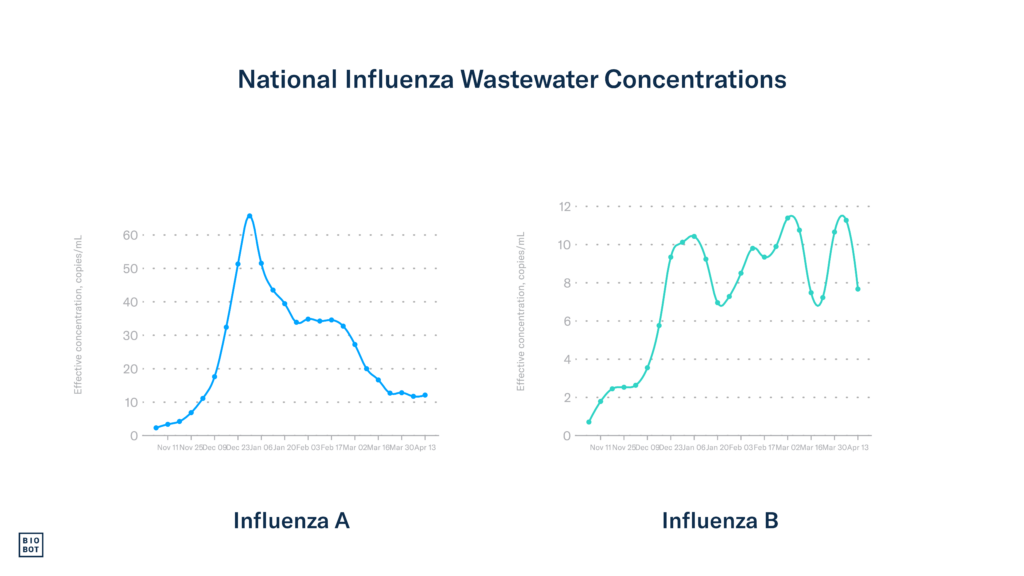Early in the COVID-19 pandemic, wastewater-based epidemiology proved to be a vital tool for...

The Biobot Network of Wastewater Treatment Plants
Advancing Wastewater as a Public Health Platform
Influenza and RSV Wastewater Monitoring in the U.S. | Week of April 15, 2024
This respiratory season, we are analyzing wastewater for the presence of respiratory syncytial virus (RSV) and influenza virus (types A and B). Together with COVID-19, these three pathogens are outsized contributors to our seasonal respiratory illness burden. In this data series, we’ll guide you through the wealth of data we’ve gathered from our Biobot Network of national sampling sites, aiming to shed light on emerging trends in respiratory virus activity and community viral load. Our goal is to equip you with information to make informed decisions, especially as we approach the holiday season and gather with family and friends.


Data Note: Samples are collected from participating locations and processed by our lab team on a rolling basis. Each point on the figure represents the weekly average concentration from Sunday – Saturday (corresponding to the MMWR week), aligned to that week’s Saturday.
Contributors

Marisa Donnelly, PhD
Public Health Partnerships Epidemiologist

Max Imakaev, PhD
Data Scientist
Previous Risk Reports
Summary: Week of 4/15/24
Biobot’s national wastewater network showed declining concentrations of SARS-CoV-2, RSV, and influenza B during week 15. Influenza A concentrations, however, have plateaued. In good news, nationally, all major clinical metrics for COVID-19 and influenza showed signs of declining illness burden during week 14, and clinical metrics for RSV showed that burden remains quite low. Notably, the percentage of outpatient visits due to influenza-like illness (ILI) finally dropped below the national baseline of 2.9% and is currently at 2.8%. With fluctuations in regional and national respiratory virus activity this season, wastewater data is proving to be a useful tool for understanding near-real-time community health trends. Wastewater and clinical monitoring continue to show that this respiratory season has been unusual, with an especially long flu season and fluctuations in viral activity.
The Bottom Line: The respiratory season is not over yet, and continued wastewater monitoring is important to keep us informed. The transmission and circulation of viruses, particularly SARS-CoV-2 and influenza, are still active. If you’re feeling unwell, it’s important to minimize contact with others, consider wearing a mask in crowded spaces, and stay current with vaccinations and boosters. Taking these precautions can help keep you and your loved ones healthy.
National Outlook
RSV
National RSV wastewater concentrations continued to decrease in week 15 (through April 13th) and are currently at the lowest levels we’ve observed since we began RSV testing in late October. National clinical RSV metrics continued to remain quite low during week 14.

Influenza
After a decline, national influenza A wastewater concentrations have plateaued through week 15 and are currently at similar levels to those observed in early December. In good news, after a spike in weeks 13 and 14, influenza B wastewater concentrations significantly decreased during week 15.
Clinical data showed that the illness burden due to influenza continued to decline in week 14, with major metrics continuing to trend downward. The number of hospitalizations due to flu decreased, with a little over 4,800 hospitalizations occurring in week 14. Test positivity from clinical labs decreased from 9.1% to 7.7%. The percentage of outpatient visits for influenza-like illness (ILI) – typical in flu, RSV, and COVID-19 patients – finally dropped below the national baseline of 2.9%, currently at 2.8%. The national baseline is determined by examining influenza-like illness outpatient visits during non-influenza weeks (roughly late spring to late summer when influenza transmission is very low) for the previous two years.

COVID-19
Wastewater data show that COVID-19 activity and community viral load slightly declined during week 15, remaining at the lowest concentrations observed during this winter surge. As of week 15, the national SARS-CoV-2 wastewater concentration average is 279 copies/mL.
Clinical metrics continued to show that COVID-19 disease burden is decreasing nationally, with all major metrics trending downward in week 14. COVID-19 hospitalizations dropped from around 8,000 in week 13 to around 7,300 in week 14. The national COVID-19 test positivity rate continues to decline, and is currently at 3.4%. Deaths due to COVID-19 declined in week 14, and currently represent 1.1% of all deaths in the US.
Regional
The South
RSV: In the South, RSV wastewater concentrations decreased during week 15. Concentrations are currently the lowest values we’ve observed for the region since we began sampling.
Influenza: The South experienced a slight uptick in influenza A wastewater concentrations during week 15, which are currently at similar levels to what we observed in late November. Influenza B wastewater concentrations slightly declined in the South during week 15 after a brief increase in week 14. During week 14, only Mississippi experienced an increase in outpatient visits due to ILI, with almost all other Southern states reporting decreases. All Southern states remained in the Minimal or Low ILI level in week 14. We’ll keep an eye on influenza A and B in the South as both are still fluctuating, but overall, influenza activity in the region is still declining.
COVID-19: SARS-CoV-2 wastewater concentrations slightly declined in the South during week 15, at 220 copies/mL. Like the trends we observe with influenza, Mississippi was the only state in the South that reported increased hospitalizations due to COVID-19. Almost all other states reported significant decreases during week 14.
The Midwest
RSV: RSV wastewater concentrations decreased in the Midwest during week 15 and are back down to levels similar to what we observed in early November. While wastewater concentrations have fluctuated somewhat in the Midwest, RSV activity remains low overall.
Influenza: Influenza A wastewater concentrations plateaued in the Midwest in week 15, while influenza B concentrations declined. In great news, all states in the Midwest experienced a decrease in outpatient visits due to influenza-like illness or held steady during week 14. Only one state remains in the High ILI activity level, with all other states at Minimal, Low, or Moderate levels.
COVID-19: SARS-CoV-2 wastewater concentrations slightly increased in the Midwest during week 15, at 322 copies/mL. During week 14, most states in the Midwest experienced a decrease in COVID-19 hospitalizations, with only two (Ohio and South Dakota) experiencing small increases. Despite some fluctuations, COVID-19 activity in the Midwest still appears to be decreasing.
The Northeast
RSV: In the Northeast, RSV wastewater concentrations continued to decline in week 15 and are currently the lowest values we observed for the region since we began sampling.
Influenza: Influenza A and B wastewater concentrations decreased in the Northeast during week 15. This is especially good news for influenza B, which peaked in the region during week 14. In week 14, most states in the Northeast saw declining outpatient visits due to ILI, with the exceptions of Vermont and New Jersey, which had slight increases. Only two states in the Northwest (New Jersey and Massachusetts) remain at the Moderate ILI level, with all other states at the Low or Minimal levels.
COVID-19: SARS-CoV-2 wastewater concentrations decreased in the Northeast during week 15 at 385 copies/mL. The Northeast appears to be having a slight uptick in COVID-19 illness burden, with seven states experiencing increases in hospitalizations due to COVID-19 in week 14. These states are New Hampshire, Maine, Vermont, Connecticut, Rhode Island, Pennsylvania, and Massachusetts. Despite these upticks, hospitalization rates remain relatively low in the region.
The West
RSV: RSV wastewater concentrations held steady and remained low in the West during week 15.
Influenza: Wastewater concentrations for influenza A remained stable and low in the West during week 15 and are at similar levels to those observed when we began sampling in late October. Influenza B concentrations decreased in week 15, signaling that the West has moved past its seasonal influenza B peak. Most states in the West experienced declines in outpatient visits due to ILI in week 14, with the exceptions of Montana, Idaho, and Nevada, which experienced increases. Currently, most states are in the Minimal or Low ILI categories, with only North Dakota remaining at the High level and New Mexico and Nebraska at the Moderate level.
COVID-19: During week 15, SARS-CoV-2 wastewater concentrations held steady in the West, currently at 177 copies/mL. In good news, most states in the West also experienced decreased hospitalizations due to COVID-19 in week 14, with Idaho as the only exception, which experienced a small increase.


Footnotes:
Wastewater data from Biobot Analytics for RSV, influenza, and SARS-CoV-2 are through April 13, 2024 (MMWR week 15). Clinical data on testing, hospitalizations, and emergency department visits for RSV, influenza, and COVID-19 are from the Centers for Disease Control and Prevention. Updates to clinical data for RSV, influenza, and COVID-19 are through April 6, 2024 (MMWR week 14).






